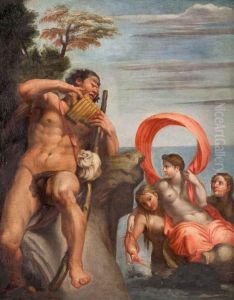Antonio Alberti Barbalonga Paintings
Antonio Alberti, known as Barbalonga, was an Italian painter born in 1600 in Messina, Sicily, which was part of the Spanish Habsburg Empire during his lifetime. He is often remembered for his contributions to the Baroque art movement, which was characterized by dramatic expression, rich coloration, and a dynamic use of light and shadow. Barbalonga's work, however, is less well-known than that of the leading figures of the Baroque era, and as a result, historical information about his life and career is somewhat limited.
Barbalonga's family background is not well-documented, but it is believed that he was born into a family with artistic interests. He trained under his father, who was also a painter, and possibly under the influence of other local artists in Messina. His early exposure to art within his family circle likely shaped his career path and his development as a painter. Despite the scarcity of detailed records, it is clear that Barbalonga established himself as a skilled artist in Messina and was involved in the rich artistic life of the city.
During his career, Barbalonga created several important works, mainly religious in nature, which were commissioned for churches and chapels. His paintings often featured biblical and hagiographic subjects, rendered with the emotional intensity and dynamism typical of the Baroque style. His artworks were noted for their vivid colors and dramatic contrasts of light and dark, which added a sense of depth and movement to the scenes he depicted.
Unfortunately, Barbalonga's life was cut short when he died in 1649 at the age of 49. The cause of his death is not well-recorded, but it was not uncommon for artists of that period to have relatively short lives due to various factors, including the prevalence of diseases and the hazardous materials often used in their work.
Despite his premature death, Barbalonga left behind a legacy of artwork that contributes to our understanding of the Baroque period in Sicily. His paintings are still studied and admired for their stylistic qualities and their embodiment of the religious and cultural milieu of 17th-century Sicily. Although he may not have achieved the same level of fame as some of his contemporaries, Barbalonga remains an important figure in the history of Sicilian Baroque art.
